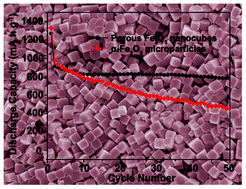Porous Fe2O3 nanocubes derived from MOFs for highly reversible lithium storage†
Abstract
Porous Fe2O3 nanocubes composed of fine Fe2O3

- This article is part of the themed collection: Structural Design of Coordination Polymers
* Corresponding authors
a
School of Chemical and Biomedical Engineering, Nanyang Technological University, 62 Nanyang Drive, Singapore 637459
E-mail:
rxu@ntu.edu.sg, xwlou@ntu.edu.sg
Web: http://www.ntu.edu.sg/home/xwlou/
Porous Fe2O3 nanocubes composed of fine Fe2O3

 Please wait while we load your content...
Something went wrong. Try again?
Please wait while we load your content...
Something went wrong. Try again?
L. Zhang, H. B. Wu, R. Xu and X. W. (. Lou, CrystEngComm, 2013, 15, 9332 DOI: 10.1039/C3CE40996A
To request permission to reproduce material from this article, please go to the Copyright Clearance Center request page.
If you are an author contributing to an RSC publication, you do not need to request permission provided correct acknowledgement is given.
If you are the author of this article, you do not need to request permission to reproduce figures and diagrams provided correct acknowledgement is given. If you want to reproduce the whole article in a third-party publication (excluding your thesis/dissertation for which permission is not required) please go to the Copyright Clearance Center request page.
Read more about how to correctly acknowledge RSC content.
 Fetching data from CrossRef.
Fetching data from CrossRef.
This may take some time to load.
Loading related content
